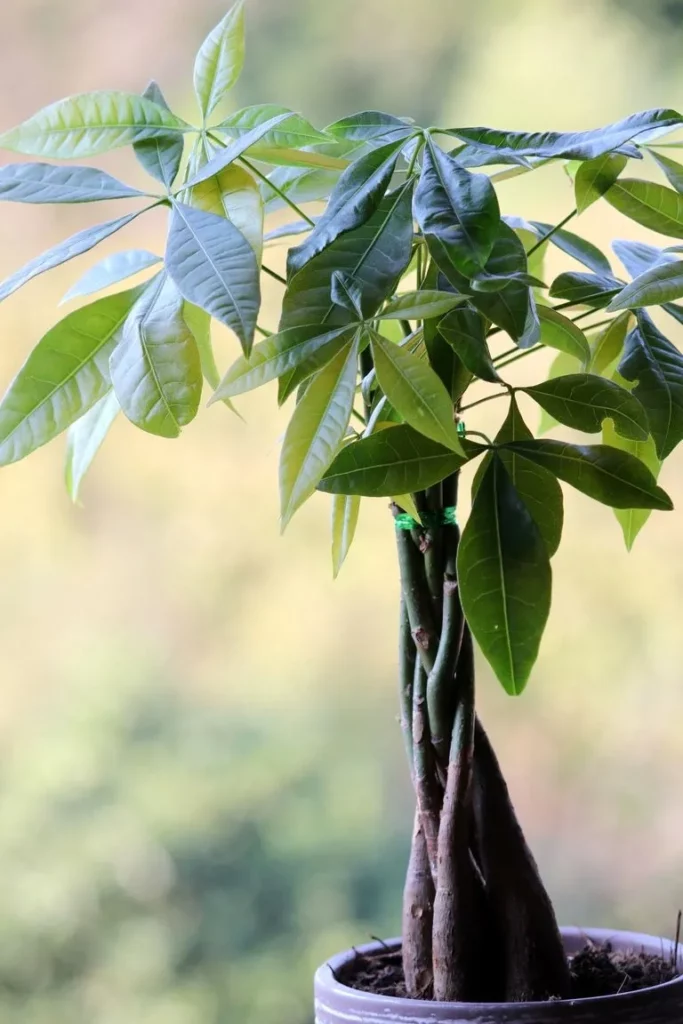If you think it’s time to add a little extra life and greenery to your space, consider getting a money tree plant. Not only are do they have a statement-making appearance, but they’re actually pretty easy to care for. Provide a money tree with the right amount of water, light, and humidity, and it’s sure to thrive. Here’s what you need to know about the popular houseplant, from the symbolism behind it to the nitty-gritty of keeping it alive and growing.
First Things First: Are Money Trees Lucky?
Money trees, aka pachira aquatica, are considered a symbol of luck and prosperity, but they haven’t been for all that long. According to Bloomscape, this doesn’t date back centuries, as you might expect, but rather to the 1980s. The braided money tree as we know it was actually first cultivated by a truck driver in Taiwan and quickly became popular in Japan and East Asia. It also became associated with the Chinese practice of Feng Shui.
The braided trunks are thought to “trap fortune within its folds,” Bloomscape explains, while the five leaves seen on each stalk are thought to represent the five elements of earth, water, fire, wind, and metal. And if you just so happen to find a money tree plant featuring a stalk with seven leaves—a major rarity—it’s considered to be even luckier.
Basic Money Tree Plant Care
Sunlight:
According to ProFlowers, money tree plants like a mix of direct and indirect sunlight. As with most houseplants, too much direct sun can scorch the leaves. To achieve the right balance with your money tree, turn or rotate it regularly for more even light distribution. Just make sure to not move it all over the place so as to not disturb it too much. Another thing of note? Money trees can handle fluorescent lighting, so you’re safe to keep one in your office as long as you take adequate care of it.
Soil:
It’s important that you maintain nutrient-rich potting soil with good drainage, according to the experts at Miracle-Gro. To achieve this, you’ll want to use a well-draining potting mix or add some sand and gravel for extra porousness.
Water:
The best way to keep a money tree plant happy? Give it a good watering every one to two weeks, allowing the soil to dry in between, according to The Sill. Of course, if your plant is getting more light, you’ll also need to up its water intake so that it doesn’t get too dried out. This is a plant that requires a lot of water but not all of the time.
Temperature and Humidity:
Money tree plants do best in warmer environments, so you’ll want to keep them in an area that’s between 65 and 75 degrees Fahrenheit. But, the good news is, money trees are also pretty flexible and forgiving. They can still handle temperatures that go 10 degrees below or above that ideal range. As far as humidity goes, money trees thrive with extra moisture, so make sure you mist your plant regularly. Bloomscape suggests putting your money tree plant on a pebble tray to increase humidity in the winter.

Braiding, Pruning, and More
While money tree plants don’t have to be braided, most of the modern pachira aquaticas you’ll find on the market are braided when you buy them. Braided money trees are actually multiple plants that have had their trunks woven together during growth while they’re flexible. If you’d like to braid your plant, try as GardeningGuides.com suggests: Weave the trunks together gently and loosely tie a string around the top to keep it together. As the tree grows, you can continue this process.
Like most houseplants, money trees also require regular pruning. First, you’ll want to keep an eye out for any dead, damaged, or dying leaves and snip those. The best way to do this is to use clean, sharp scissors or pruning shears (and make sure you wipe them off between cuts!) and clip them just past a node. You can also prune them to be a specific shape if you prefer. Money tree plants are traditionally round on top, but you can also let your plant do its own thing and just prune problematic parts to keep your plant thriving and encourage new growth. You can also prune your plant to keep it small if you’d like, as money tree plants can grow quite tall (according to Garden.org, they can grow up to 60 feet in their natural habitat!).
Common Money Tree Problems
Since money tree plants require a lot of water all at once, they can be prone to root rot. Root rot, if you’re unfamiliar, is when there’s too much water in your plant that causes the roots to decay and die. When you’re watering your plant, make sure you don’t see extra water sitting in the saucer under the drainage holes. If you do, clear it out to avoid root rot. Your best bet is to use a pot that isn’t too big (the bigger the pot, the more room it has to hold water) and has excellent drainage. Place it on a saucer that you can easily remove, and dump out when it fills with water.
Money tree plants can also attract pests like aphids and mealybugs, but not to worry—Epic Gardening suggests applying neem oil to the soil to repel any pests and removing aphids with water. All of these pests can cause major damage to your plant, so make sure you deal with them as soon as you see them to avoid loose, drooping, dying leaves.
By Brittney Morgan for House Beautiful 2/2/2022
Original Article Here
For more information, please contact us here.



